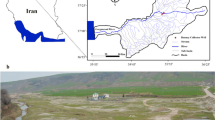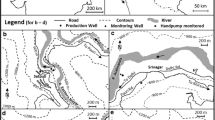Abstract
Riverbank filtration (RBF) is an efficient and low-cost natural alternative technology for water supply application in which surface water contaminants are removed or degraded as the infiltrating water moves from the river to the pumping wells. In this study, a full-scale RBF site consisting of three vertical wells installed 50 m from Nile bank was investigated. The RBF systems are particularly well suited for providing better water quality than withdrawal directly from the Nile River to produce drinking water for New Aswan city. The study is carried out by taking samples over 1 year from riverbank filtrates wells, Nile River (as induced surface water), and some production wells were collected and analyzed. Physicochemical and microbiological measurements such as turbidity, dissolved oxygen, total suspended solids, total organic carbon, total dissolved solids, electrical conductivity, pH, Fe, Mn, NH3, NO2, NO3, PO4, Ca, Mg, Na, K, HCO3, SO4, Cl, total bacteria, and total coliform were carried out. The results of bank filtrate were compared with those of the natural groundwater and previous reported Nile water. Chemical and bacterial quality parameters of RBF are under the allowable limits for drinking water. Moreover, bank filtration is simultaneously improved the ambient groundwater and cleaned Nile water in the studied area. Result of this full-scale RBF plant showed the effectiveness of riverbank filtration as a proven treatment technique in Nile Valley with a fraction of cost comparing to conventional surface treatment plants.















Similar content being viewed by others
References
Abdel Mohsin S (1979) Geological studies on the iron-bearing formation east of Aswan. M. Sc. Thesis. Geol. Dept., Fac. Sci., Assiut Univ., Egypt
APHA, AWWA, WEF (1998) Standard methods for the examination of water and wastewater, 20th edn. American Public Health Association, Washington, DC
APHA, AWWA, WEF (2012) Standards methods for the examination of water and wastewater, 22nd edn. America Public Health Association, Washington D.C
Bauer R, Dizer H, Graeber I, Rosenwinkel K, Lopez-Pila J (2011) Removal of bacterial fecal indicators, coliphages and enteric adenoviruses from waters with high fecal pollution by slow sand filtration. Water Res 45:439–452
Butzer KW, Hanson CL (1968) Desert and river in Nubia. University of Wisconsin Press, Madison, 562
Dastanaie AJ, Nabi Bidhendi GR, Nasrabadi T, Habibi R, Hoveidi H (2007) Use of horizontal flow roughing filtration in drinking water treatment. Int J Environ Sci Tech 4(3):379–382
Davies-Colley RJ, Smith DG (2001) Turbidity, suspended sediment, and water clarity—a review. J Am Water Resour Assoc 37(5):1085–1101
Donald D and Grygaski T (2002) Development of a sustainable potable water supply for rural villages in the coastal region of Tanzania, Africa. ENVE 431 Final Project Report. University of Waterloo, Ontario
Doussan C, Poitevin G, Ledoux E, Detay M (1997) Riverbank filtration: modeling of the changes in water chemistry with emphasis on nitrogen species. J Contam Hydrol 25:129–156
El Ramly IM (1973) Geomorphology, hydrogeology, planning for groundwater resources and land reclamation in Lake Nasser region and its environs. Report from Desert Research Institute to Lake Nasser development center Aswan, Cairo, A.R.E
El Shazly EM, Adel Hady MA, El Ghaay MA, El Kassas IA (1974) Geological interpretation of ERTS-1satallite images for west Aswan area, Egypt. Proceeding of the ninth international symposium on remote sensing of environment, 15–19 April (1974), Arbor. Michigan, USA, pp 119–131
Grischek T, Schoenheinz D, Syhre C, Saupe K (2009) Impact of decreasing water demand on bank filtration in Saxony, Germany. Drink Water Eng Sci Discuss 2:101–126
Gunkel G, Hoffmann A (2009) Bank filtration of rivers and lakes to improve the raw water quality for drinking water supply. In: Gertsen N, Sønderby L (eds) Water purification. Nova Science, Hauppauge, pp 137–169
Hendriks F, Luger P, Bowitz J and Kallenbach H (1987) Evolution of the depositional environments of SE Egypt during the cretaceous and lower tertiary. Berliner Geowiss Abh (A) 75: 49–82
Hiscock KM, Grischek T (2002) Attenuation of groundwater pollution by bank filtration. J Hydrogeol 266:139–144
Hoffmanna A, Gunkel G (2011) Carbon input, production and turnover in the interstices of a Lake Tegel bank filtration site, Berlin, Germany. Limnologica 41:151–159
Hoppe-Jones C, Oldham G, Drewes J (2010) Attenuation of total organic carbon and unregulated trace organic chemicals in U.S. riverbank filtration systems. Water Res 44:4643–4659
Ibrahim HA, Omran AA, Selim SA (1990) Geoelectrical study on the area west of Aswan town, Egypt. Bull Fac Sci Assiut Univ Egypt 19:25–36
ASTM International (2003) D1889–00 Standard test method for turbidity of water. In: ASTM International, Annual Book of ASTM Standards, Water and Environmental Technology, 2003, V. 11.01, West Conshohocken, Pennsylvania, p 6
Irmscher R, Teermann I (2002) Riverbank filtration for drinking water supply-a proven method, perfect to face today’s challenges. Water Sci Technol Water Supp 2(5–6):1–8
Issawi B (1981) Geology of the southwestern Desert of Egypt. Geol. Survey. Egypt, Cairo, XI: 57–66
Khader ES (1978) Some geological studies on the unconformity zone between the basement and the Nubia sandstone in Aswan area. Ph.D. Thesis. Geol. Dept., Assiut Univ., Aswan, Egypt p 213
Klitzsch EH and Wycisk P (1987) Geology of the sedimentary basins of northern Sudan and bordering areas. Berliner Geowiss Abh A 75(1):97–136
Kuehn W, Mueller U (2000) Riverbank filtration: an overview. J Am Water Works Assoc 92(12):60–69
Massmann G, Dünnbier U, Heberer T, Taute T (2008) Behaviour and redox sensitivity of pharmaceutical residues during bank filtration-investigations of residues of phenazone-type analgesics. Chemosphere 71:1476e1485
Ray C (2001) Riverbank filtration: an analysis of parameters for optimal performance. In: AWWA Annual Conference, Washington DC
Schubert J (2002a) Hydraulic aspects of riverbank filtration-field studies. J Hydrogeol 266:145–161
Schubert J (2002b) Water quality improvements with riverbank filtration at Düsseldorf waterworks in Germany. In: Ray C, Melin G, Linsky RB (eds) Riverbank filtration: improving source water quality. Kluwer, Dordrecht, pp 267–280
Schwarzenbach RP, Escher BI, Fenner K, Hofstetter TB, Johnson CA, von Gunten U, Wehrli B (2006) The challenge of micropollutants in aquatic systems. Science 313:1072–1077
Selim SA (1995) Geological and hydrogeological studies of the quaternary aquifer in Aswan town area, Egypt. Egypt J Geol 39(2):631–646
Shamrukh M, Abdel-Wahab A (2008) Riverbank filtration for sustainable water supply: application to a large-scale facility on the Nile River. Clean Techn Environ Policy 10:351–358
Sharma L, Greskowiak J, Ray C, Eckert P, Prommer H (2012) Elucidating temperature effects on seasonal variations of biogeochemical turnover rates during riverbank filtration. J Hydrol 428–429:104–115
Singh P, Kumar P, Mehrotra I, Grischek T (2010) Impact of riverbank filtration on treatment of polluted river water. J Environ Manag 91:1055–1062
Sprenger C, Lorenzen G, Hülshoff I, Grützmacher G, Ronghang M, Pekdeger A (2011) Vulnerability of bank filtration systems to climate change. Sci Total Environ 409:655–663
Van Houten FB and Bhattacharyya DP (1979) Late cretaceous Nubia formation at Aswan south Eastern Desert, Egypt. Annals Geolog Surv Egypt Vol. IX pp 408–431
Verstreaeten IM, Heberer T (2002) Organic chemical removal issues. In: Ray C, Melin G, Linsky RB (eds) Riverbank filtration: improving source-water quality, chapter 17. Kluwer, Dordrecht
Vogt T, Hoehn E, Schneider P, Freund A, Schirmer M, Cirpka OA (2010) Fluctuations of electric conductivity as natural tracer for bank filtration in a losing stream. Adv Water Resour 33:1296–1308
World Health Organization (2005) Guidelines for drinking-water quality. 2nd edn, vol 1. Recommendations
Author information
Authors and Affiliations
Corresponding author
Rights and permissions
About this article
Cite this article
Hamdan, A.M., Sensoy, M.M. & Mansour, M.S. Evaluating the effectiveness of bank infiltration process in new Aswan City, Egypt. Arab J Geosci 6, 4155–4165 (2013). https://doi.org/10.1007/s12517-012-0682-7
Received:
Accepted:
Published:
Issue Date:
DOI: https://doi.org/10.1007/s12517-012-0682-7




